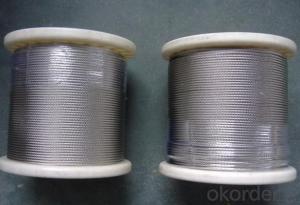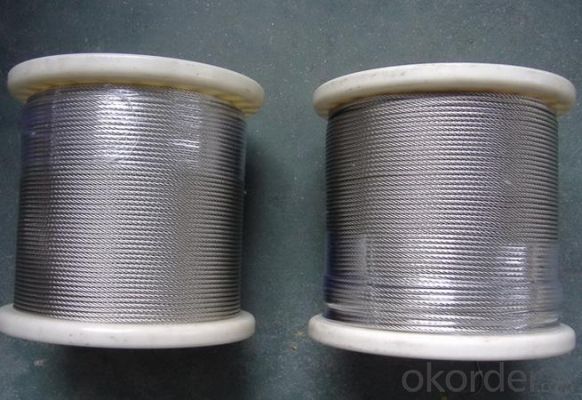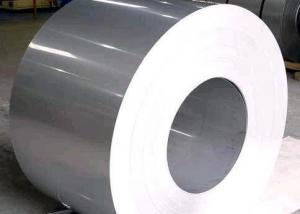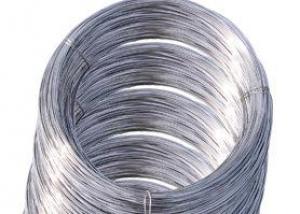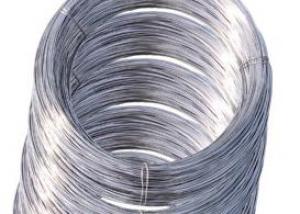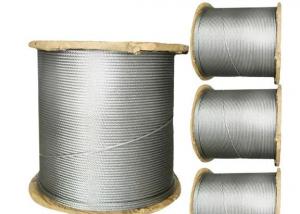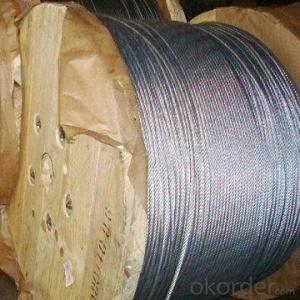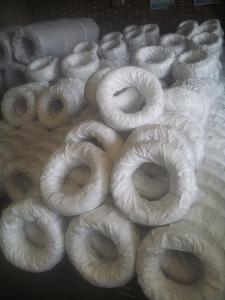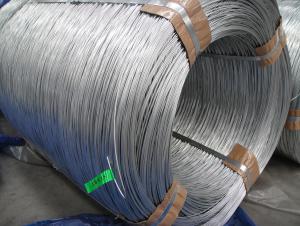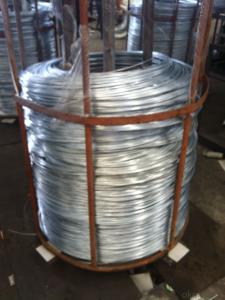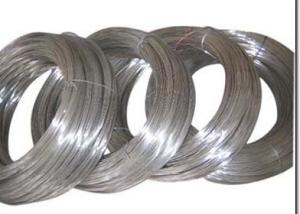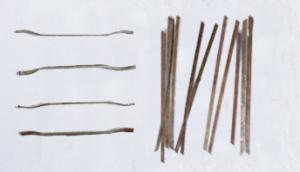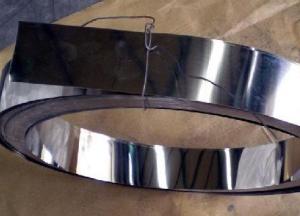Wire Galvanized Steel Wire Rod for ACSR
- Loading Port:
- Qingdao
- Payment Terms:
- TT OR LC
- Min Order Qty:
- 10 m.t.
- Supply Capability:
- 50000 m.t./month
OKorder Service Pledge
OKorder Financial Service
You Might Also Like
Specification
Wire Galvanized Steel Wire Rod for ACSR
Description
1. Material: Q195,Q235,45#,60#,65#,70#,72B,80#,82B,65Mn
2. Surface Coating: Galvanized
3. Characteristic: High tensile strength,small tolerance
Shiny surface, good corrosion prevention
4. Packing type:Spool or Coil
5. Application: Being used for stranded conductors in overhead power circuitry
6. Remarks during use and handling:
a. During transportation, handle softly and carefully, avoid bumping and damaging the steel wires. Moisture and rain prohibited. Steel wires must be stored in dry and well ventilated indoors
b. Pay attention to the direction of steel wires when paying-off. Be sure the spool or coil is rotating freely as to achieve identical tension of all the steel wires
c. In case of batch usage, the remaining should be repacked to avoid oxidizing of the surface
Technical Parameters
Wire dia: 1.24-5.5mm; Tensile Strength:1290~1340Mpa
Nominal diameter (mm) | Tensile Strength | Stress at 1% Elongation | Twist | Elongation | Standard |
mm | Mpa | Mpa | Times/360° | Lo=250mm | |
1.24~2.25 | ≥1340 | ≥1170 | ≥18 | ≥3.0% | As per GB,EN,IEC,JIS,ASTM standard, as well as customer's request |
2.25~2.75 | ≥1310 | ≥1140 | ≥16 | ≥3.0% | |
2.75~3.00 | ≥1310 | ≥1140 | ≥16 | ≥3.5% | |
3.00~3.50 | ≥1290 | ≥1100 | ≥14 | ≥3.5% | |
3.50~4.25 | ≥1290 | ≥1100 | ≥12 | ≥4.0% | |
4.25~4.75 | ≥1290 | ≥1100 | ≥12 | ≥4.0% | |
4.75~5.50 | ≥1290 | ≥1100 | ≥12 | ≥4.0% |
Packaging & Delivery
Packaging Details: | Coil with plastic outside or according to customer's requirement. |
Delivery Detail: | 20 working days after receiving your order. |
Products Show
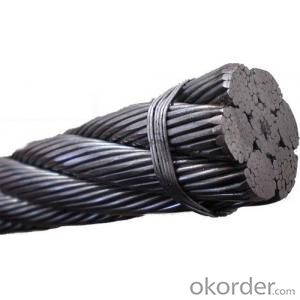

- Q: Can stainless steel wire be used for netting or mesh?
- Certainly, netting or mesh can be made using stainless steel wire. Stainless steel is a material that possesses exceptional durability and resistance to corrosion, making it the perfect choice for applications that demand both strength and longevity. Commonly employed for fencing, safety barriers, animal enclosures, filtration, and even decorative purposes, stainless steel wire mesh is renowned for its remarkable tensile strength, flexibility, and ability to withstand rust and harsh environmental conditions. Consequently, stainless steel wire netting or mesh enjoys immense popularity within a multitude of industries including construction, agriculture, mining, food processing, and various others.
- Q: Can stainless steel wire baskets be used for food storage?
- Stainless steel wire baskets are suitable for food storage purposes. This material is renowned for its robustness, ability to resist corrosion, and non-reactive characteristics, rendering it a secure and hygienic option for storing edibles. In various settings, such as commercial kitchens, food processing plants, and even domestic kitchens, stainless steel wire baskets are commonly utilized to store fruits, vegetables, bread, and other food items. The wire construction facilitates proper air circulation, thereby averting moisture accumulation and prolonging the freshness of the stored food. Moreover, stainless steel is effortlessly cleaned and maintained, making it a practical preference for food storage.
- Q: What are the different finish options available for stainless steel wire?
- Stainless steel wire offers a variety of finish options to enhance its appearance, performance, and protection against corrosion and wear. One option is a bright or mirror finish, achieved by polishing the wire to a high shine. This creates a reflective surface that is visually appealing and easy to clean. It is commonly used in decorative applications like jewelry or architectural elements. Another choice is a brushed or satin finish. This involves brushing the wire with a fine abrasive material to create a textured surface. It has a slightly matte appearance and is ideal for applications where a more subdued and industrial look is desired. A third option is a coated or painted finish, which adds a layer of paint or protective coating to the wire. This provides extra defense against corrosion and wear. The coating can be clear or colored, depending on the desired aesthetic. Lastly, there is the mill finish, which is the standard finish that stainless steel wire has when it is initially produced. It has a dull, matte appearance with minor imperfections. This finish is commonly used in industrial or structural applications where appearance is not the primary concern. Ultimately, the choice of finish for stainless steel wire depends on the specific application and desired aesthetic. Each option offers unique benefits and characteristics, allowing for a wide range of possibilities when working with stainless steel wire.
- Q: How can stainless steel rod be made of silk?
- The axis alignment is the key to the experience and feeling, and is coated with a layer of special tapping oil between the die and the polished rod, is not easy to stick a knife. It also can be used for turning the car, with knife, a long rod can also be processed
- Q: Can stainless steel wire be used for wire rope turnbuckles?
- Yes, stainless steel wire can be used for wire rope turnbuckles. Stainless steel is a popular choice for turnbuckles and wire ropes due to its resistance to corrosion and durability. It provides excellent strength and reliability, making it suitable for various applications including marine, construction, and industrial settings. Stainless steel wire rope turnbuckles offer reliable tension adjustment and are often used in situations where high strength and corrosion resistance are required.
- Q: Can the 8.8 screw be replaced by A2-70 stainless steel screw?
- It can be seen above the performance or by the difference, but also willing to do analysis of whether the use of force according to the product, if the screw to some special surface treatment can also improve corrosion resistance of lai,
- Q: What are the different types of stainless steel wire rope constructions?
- There are several different types of stainless steel wire rope constructions, including 1x19, 7x7, and 7x19. The 1x19 construction consists of a single strand with 19 wires, offering high strength and minimal flexibility. The 7x7 construction has seven strands, each consisting of seven wires, providing a balance between strength and flexibility. Lastly, the 7x19 construction has seven strands, each consisting of 19 wires, offering maximum flexibility but slightly less strength compared to the other constructions.
- Q: What are the different wire coatings available for stainless steel wire?
- Stainless steel wire can be coated with various materials, each with their own unique features and advantages. PVC, for instance, is a common coating that offers great resistance against abrasion and chemicals, making it suitable for usage in harsh environments. Nylon coating, on the other hand, provides greater flexibility and durability. This type of coating is often used in applications that demand high tensile strength and resistance to moisture. Additionally, there are specialty coatings like Teflon or PTFE, which are perfect for high-temperature or high-friction scenarios due to their exceptional temperature resistance and low friction properties. It is crucial to select a wire coating that matches the specific requirements of the intended use, taking into account factors such as environmental conditions, mechanical stress, and exposure to chemicals.
- Q: Can stainless steel wire be supplied in custom tensile strengths?
- Yes, stainless steel wire can be supplied in custom tensile strengths. The tensile strength of stainless steel wire can be customized during the manufacturing process by adjusting the composition, heat treatment, and production methods. This allows for the production of stainless steel wire with varying levels of strength to meet specific requirements and applications. Whether you need high tensile strength or lower tensile strength stainless steel wire, it is possible to have it customized based on your needs.
- Q: How can stainless steel and copper wire be welded?
- If it can be used for brazing, silver based solder solder with high temperature for welding of copper and stainless steel, but this is the need for flame welding, but if it is the relatively thin copper wire should be used with caution, so as not to burn the wire.
Send your message to us
Wire Galvanized Steel Wire Rod for ACSR
- Loading Port:
- Qingdao
- Payment Terms:
- TT OR LC
- Min Order Qty:
- 10 m.t.
- Supply Capability:
- 50000 m.t./month
OKorder Service Pledge
OKorder Financial Service
Similar products
Hot products
Hot Searches
Related keywords
